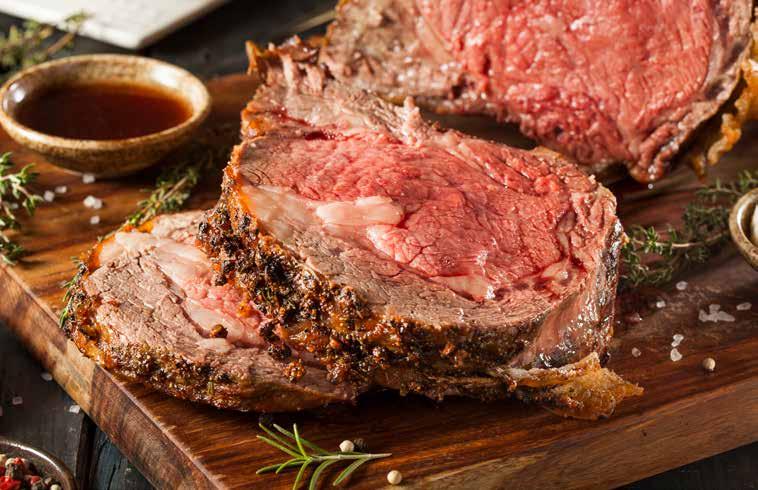
3 minute read
Bring on the Beef
A special time of year calls for a special meal. In ranch country, we prefer to put beef on the table, so here are some tips for serving prime rib this holiday season. Recipes and cooking directions from beefitswhatsfordinner.com
COWBOY STEAK AND ROAST RUB
INGREDIENTS DIRECTIONS
2 teaspoons sweet paprika 1-1/2 teaspoons dried thyme leaves Combine all ingredients in small bowl; press evenly onto beef steak(s) or roast.
1 teaspoon garlic powder Grill, pan-broil or broil steaks; place roast 1 teaspoon onion powder in oven and cook according to chart. Cook to medium rare (145°F) to medium (160°F) 1/2 teaspoon salt (optional) doneness. Cooking Prime Rib 1/2 teaspoon pepper The best way to cook Prime Rib, or the Ribeye Roast, is by roasting it in the oven fat side up to your desired doneness and allowing it to rest, tented by aluminum foil for 10-15 minutes before slicing. This will ensure that the juices have a chance to settle before cutting into the roast. It’s also important to remember the temperature will continue to rise 10 to 15 degrees when it comes out of the oven.
Roasting times may vary depending on the size of the roast and if it is boneless or not. These roasting guidelines can offer a general rule of thumb. But, it’s always best to follow the individual recipe or packaging for specific times, and use an accurate meat thermometer to keep an eye on the internal temperature.
Prime Rib
oven temperature (preheated) Ribeye Roast, Boneless (small end) 350°F
Ribeye Roast, Boneless (large end) 350°F weight (pounds)
3 to 4 4 to 6 6 to 8
3 to 4 4 to 6 6 to 8 Approximate Internal TEMPERATURE*
Medium Rare: 135°F Medium: 145°F Medium Rare: 135°F Medium: 145°F Medium Rare: 135°F Medium: 145°F
Medium Rare: 135°F Medium: 145°F Medium Rare: 135°F Medium: 145°F Medium Rare: 135°F Medium: 145°F Total Cooking TIme
1-1/2 to 1-3/4 hours 1-3/4 to 2 hours 1-3/4 to 2 hours 2 to 2-1/4 hours 2 to 2-1/4 hours 2-1/4 to 2-1/2 hours
1-1/2 to 2 hours 2 to 2-1/4 hours 2 to 2-1/4 hours 2-1/4 to 2-1/2 hours 2-1/4 to 2-1/2 hours 2-1/2 to 2-3/4 hours
Ribeye Roast, Bone-In 350°F 4 to 6 (2 ribs) 6 to 8 (2 to 4 ribs) 8 to 10 (4 to 5 ribs)
Medium Rare: 135°F Medium: 145°F Medium Rare: 135°F Medium: 145°F Medium Rare: 135°F Medium: 145°F 1-3/4 to 2-1/4 hours 2-1/4 to 2-3/4 hours 2-1/4 to 2-1/2 hours 2-1/2 to 3 hours 2-1/2 to 3 hours 3 to 3-1/2 hours
Tips for

Bring on the Beef!
How to Carve a Prime Rib

To get delicious, even slices from the Prime Rib, first turn the roast on its side and remove the ribs. To do this, follow the curve of the ribs as close and you can, making sure to hold the roast steady with a serving fork or tongs. Once the ribs are removed, turn the roast with the fat side up and carefully slice pieces to the desired thickness.
Buying Prime Rib
When cooking for 4 people or fewer, it might be better to purchase steak or call ahead to your meat counter to order the size of roast you prefer. For bone-in prime rib, plan one rib for every two people.
At the store, prime rib can go by different names including standing rib roast, holiday roast or ribeye roast. It can be found in the meat case with both boneless and bone-in options. The ribeye roast comes from the rib primal which gives it the rich, beefy flavor everyone loves. It is savory, fine-textured and typically has generous marbling. If you’re having your own beef butchered, make sure you specify that you want a prime rib roast, and tell the butcher the size.
Pairing Wine with Prime Rib
With a prime rib, the meat is tender, savory and rich with a good amount of marbling. This translates to big flavors. This is when the young, bold wines, like Cabernet Sauvignon, come in. The marbling in the prime rib interacts with the harsh tannins of the young Cabernet bringing out the great fruit taste.
Some other excellent wines to pair with a prime rib include a Syrah, Rhome Valley, Rioja or Barolo.






